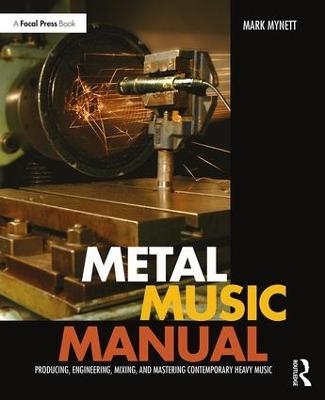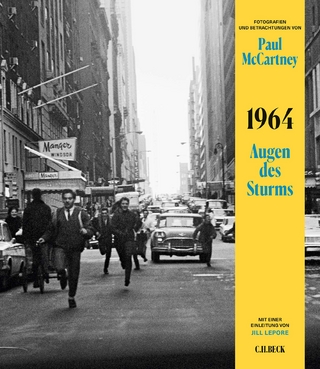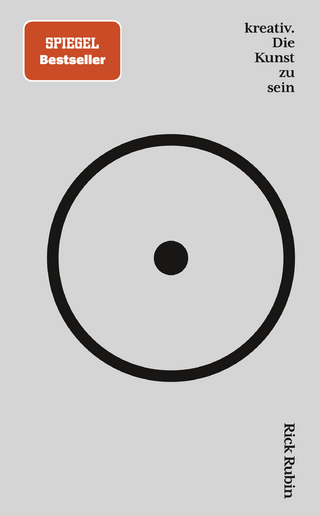
Metal Music Manual
Routledge (Verlag)
978-1-138-80932-1 (ISBN)
The extensive companion website features multi-track recordings, final mixes, processing examples, audio stems, etc., so you can download the relevant content and experiment with the techniques you read about. The website also features video interviews the author conducted with the following acclaimed producers, who share their expertise, experience, and insight into the processes involved:
Fredrik Nordström (Dimmu Borgir, At The Gates, In Flames)
Matt Hyde (Slayer, Parkway Drive, Children of Bodom)
Ross Robinson (Slipknot, Sepultura, Machine Head)
Logan Mader (Gojira, DevilDriver, Fear Factory)
Andy Sneap (Megadeth, Killswitch Engage, Testament)
Jens Bogren (Opeth, Kreator, Arch Enemy)
Daniel Bergstrand (Meshuggah, Soilwork, Behemoth)
Nick Raskulinecz (Mastodon, Death Angel, Trivium)
Quotes from these interviews are featured throughout Metal Music Manual, with additional contributions from:
Ross "Drum Doctor" Garfield (one of the world’s top drum sound specialists, with Metallica and Slipknot amongst his credits)
Andrew Scheps (Black Sabbath, Linkin Park, Metallica)
Maor Appelbaum (Sepultura, Faith No More, Halford)
Mark Mynett is a record producer, recording-mixing-mastering engineer, author, and Senior Lecturer in Music Technology and Production at the University of Huddersfield, England. As both musician and producer, he has over 20 years' experience in the metal genre; has written numerous heavy-music production articles for leading magazines, including Sound on Sound and Guitar World; and in 2013 gained the world’s first PhD in Contemporary Metal Music Production. He owns his own studio, Mynetaur Productions (www.mynetaur.com), where he provides engineering, mixing and mastering services for clients from all over the world.
Acknowledgments
Foreword
Chapter 1: Introduction
Audio
Video Interviews
Forum
Chapter 2: Contemporary Metal Music
Chapter 3: The Parameters of Heaviness
Distortion
Proximity
Perceived Loudness
The Distortion Paradox
Sonic Weight
Transients
Spectral Dynamics and Transient Brightness
Clarity
Definition
Intelligibility
Performance Precision
Pre-Production
Chapter 4: Pre-Production
Vision and Leadership
Rehearsals
The Budget
Click Tracks
In Practice
Tempo Mapping
Click Tones
Guide Tracks
Click-Free Tracking
Live Guide Tracks without a Click
Overdubs without a Click
The Click Track Acid Test
Chapter 5: Sound at Source
Drums
Drum Shells
Shell Thickness, Diameter, Depth and Hardware
Symmetry and Flatness
Drumheads and Re-Heading
Batter Heads
Resonant Heads
Re-Heading/Bedding-In
Drum Tuning
Kick Tuning
Snare Tuning
Toms Tuning
Dampening
Kick Dampening
Snare and Toms Dampening
Hats, Ride and Cymbals
Bass and Guitar
Down-Tuning
Baritones/Longer Scale Lengths
Guitar Overdrive Pedals
Amp/Cab/Mic Simulation and Modelling
Amplifiers
Bass Amps
Guitar Amps
Loudspeakers and Loudspeaker Cabinets
Engineering
Chapter 6: Engineering Overview
Isolation=Separation=Control
Headroom
Printed Compression
Printed EQ
Chapter 7: Drums
Set Up
Kick Drums
Attack Mic
Porthole Placement
Low Frequency Capture
Isolation Tunnels
Double Kick Performance Solutions
Kick Building
Snare Top
Snare Bottom
Toms
Batter Mic
Double Miked Toms
Concert Toms
Metalwork
Hats
Ride
Cymbals
Spaced Pair
Close Miked Cymbals
Paired Cymbal Miking
Room Mics and Controlled Cohesion
Triggers
Recording Drum Hits from the Kit used for Tracking
Sample Creation
Drum Edits and Quantization
Gridding
Phase
Retention of Human Feel
Micro-Editing
Quantization-Based Tools
Chapter 8: Guitars
D.I.’s and Re-amping
Speaker Selection
Isolation Tactics
Amp Volume
Mic Selection
Loudspeaker Frequency Radiation
Mic Placement
Proximity Effect
Off-Axis Placement
Double Miking
Double Tracking (vs. Quad Tracking)
Quad Tracking
Tonal Variation
Multi Amp/Cab Recording for Double-Tracked Guitars
Mix Center Rhythm Thickener
Chapter 9: Bass
D.I.
Dirty D.I.
(Series) Amp/Cab Distortion
Amp/Cab/Mic
Isolation, Speaker Selection & Master Volume
Mic Selection
Mic Placement
Double Miking
Phase Alignment
Emulation
Layers
(Parallel) Reinforcement Distortion
Chapter 10: Vocals
Scheduling
Coaching, Communication and Comping
Engineering
Polar Patterns and Gang Vocals
Handheld Vocal Recording
Vocal Compression
Monitoring
Headphone-less Vocal Recording
Recording Further Instruments
Mixing
Chapter 11: Edits, Polarity and Phase Alignment, Samples and Gates
Edits
Mix Groups
Polarity and Phase Alignment
Drums
Phase Alignment
Bass
Guitars
Waveform Edits
Multing
Drum Samples – Overview
Drum Sample Selection
Drum Samples Libraries vs. Samples Created from the Kit used for Tracking
Kick Sample Selection
Snare Sample Selection
Tom Sample Selection
Sample Implementation
Kick
Snare
Toms
Isolation vs. Cohesion
Gating
Kick and Snare Gating
Keyed Gating
Toms: Gating vs. Automation vs. Waveform Edits
Chapter 12. Balance and Stereo Width
Mix Group Component Balance
Mix Balance
Panning and Stereo Width
Mix Center
Sides
Monitoring and Room Acoustics
Monitoring Level
Headphone Monitoring
Chapter 13: Compression
Signal Chain Order
Compression Parameters
Timbral Coloration and Transient Design
Drum Compression
Signal Stability
Punch
Transient Design
Attack Settings
Release, Threshold, Ratio
Make-Up Gain
Hats, Ride, and Cymbal Compression
Room Mic Compression
Parallel Compression
Drum Bus Compression
Bass Compression
Reinforcement Distortion
Series Bass Compression
Signal Bracketing
Parallel Bass Compression
Bass Automation
Keyed Compression
Rhythm Guitar Compression
Palm Muted ‘Chug-Thump’
Lead Guitar Compression
Vocal Compression
Parallel Vocal Compression
Sibilance and De-Essing
Limiting
Chapter 14: EQ
Parametric EQ
High Pass Filters
Sweep EQ
Corrective and Surgical EQ
Instrument EQ
Drums
Kick Drum
Optimized Kick HPF Cut Settings
Kick Weight
Low-Mids – Broad Corrective EQ
Attack/Click
Frequency Bracketing
Snare Top/Snare Samples
The Baxandall Curve
Intelligent EQ
Snare Bottom
Toms
Context and Interdependence
Metalwork
Room Mics
Low Pass Filters
Spectral Masking
Distributed Creative and Corrective EQ
Anti-Masking in Mono
Bass
The Missing Fundamental
Low-End
Low-Mids
High-Mids
Additional Layers
Bass Reinforcement Distortion
Frequency Bracketing
Channel EQ / Group EQ
Rhythm Guitar EQ
HPF and Low Frequency Emphasis (Cabinet Thump/Sonic Weight)
Mids
Big Mono vs. Panoramic Width
Low highs – Mid Highs
Mirrored EQ
Dynamic EQ
Vocals
HPF and Lows to Low Mids
Mids
Highs
Chapter 15: Effects Processing and Automation
Reverb
Reverb Decay and Pre-Delay Times
Drums
Decay vs. Level
Snare Reverb – Aux Sends
Guitars and Bass
Vocals
Processing the Reverb Return Paths
EQ
(Reverb Return) Transient Design, Compression, Tape Emulation and Pitch Shifting
Reverse Reverb, Special Effects and Automation
Delay
Processing the Delay Return Paths
Pitch Thickening Width Enhancement
Distortion
Parallel Snare Distortion
Megaphone and AM Radio Effect
Sine Wave or White Noise Reinforcement
Analogue and Tape Emulation
Mix Referencing
Automation
Chapter 16: Master Buss Processing
Master Buss Compression
Master Buss EQ
Master Buss Limiting
Summing
Mastering
Chapter 17: Mastering
DIY and the ‘Four Es’ of Mastering
Signal Chain
Mastering EQ
High Pass Filters and Low End Control
Low-Mids and Mids
Low-End Foundation
Upper Mids and High Frequencies
Stereo EQ vs. Mid/Side EQ
Low-end Localization
Reverb
Unified Mastering – Bridging the Divide
Compression
Broadband Compression vs. Multiband Compression
Broadband Compression
Mid/Side Compression
Side Chain Filtering
Multiband Compression
Two Band
Three-Band
Four-Band
Multiband Parameters
Low Band
Mid Band
High Band
Mid/Side Multiband Compression
Parallel/Upward Compression
Harmonic Enhancement
Stereo Width Enhancement
Stem Mastering
Soft Clipping
Limiting
Automation
Fades
Mastered Output Peak Levels - CD
Chapter 18: Loudness Normalization
Loudness Metering and Mastering Practice
A Final Word
Index
| Erscheint lt. Verlag | 13.3.2017 |
|---|---|
| Verlagsort | London |
| Sprache | englisch |
| Maße | 191 x 235 mm |
| Gewicht | 920 g |
| Themenwelt | Kunst / Musik / Theater ► Musik ► Pop / Rock |
| Mathematik / Informatik ► Informatik | |
| ISBN-10 | 1-138-80932-2 / 1138809322 |
| ISBN-13 | 978-1-138-80932-1 / 9781138809321 |
| Zustand | Neuware |
| Haben Sie eine Frage zum Produkt? |
aus dem Bereich


